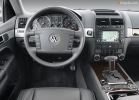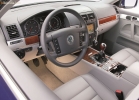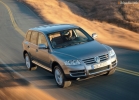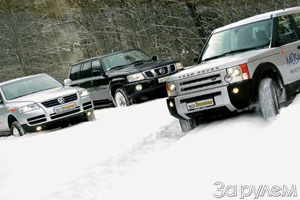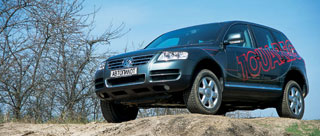Test drive Volkswagen Touareg 2002 - 2007 SUV
Dancing on the verge of summer
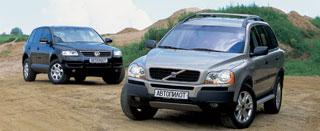 In the Swiss car catalog, both companies are located at the very end. In life, they claim to become the first in the niche occupied by Volvo XC90 and Volkswagen Touareg.
In the Swiss car catalog, both companies are located at the very end. In life, they claim to become the first in the niche occupied by Volvo XC90 and Volkswagen Touareg. In a high -profile party, which prefers the most expensive and preferred, until recently, the conversation of the boys turned exclusively around two models of this class: BMW X5 and Mercedes ML. Girls were goured about the Lexus RX300. But first, in a whisper, and then in full voice they started talking about beginners of this class - VW Touareg and Volvo XC90. Moreover, they are cheaper than favorites, and novelty gives them piquancy. At the same time, the muscular appearance suggests good off -road qualities - everything seems to be known about the possibilities of competitors for a long time.
Figure First: Waltz. Yes, throw you, ”the one who looks at such cars is not down, but from afar,“ such cars are bought exclusively for show -offs: their owners from asphalt do not move, but love to drive in cars with a powerful motor and high landing. We do not agree with this point of view: each owner of an all-terrain car must someday break the tower, and he out of order to eagerly rushes to the first laundry of the sagging. This is our Russian character. Therefore, having received these two cars for the test, they decided to simulate the classical situation and combine the trip out of town with spontaneous pokatushki somewhere along the way, in silence and peace.
From the city we escaped along the Rogachevsky highway. It is the best suited for testing the sled qualities of any car - narrow, winding, with height drops. In Soviet times, high -speed dopes of rally competitions were laid on it.
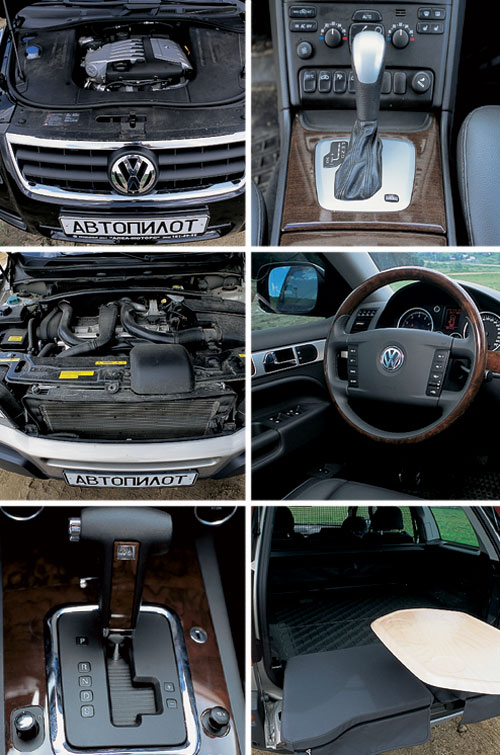
Our additional margin won the Volvo XC90. And not only thanks to a more powerful, turbocharged motor. In fairness, we note that the impression of the Volvo power plant was pretty spoiled by a box. There are only four programs in it, and they are too stretched in the range from minimum to maximum speed. In urban mode, this is generally not bad - the car is confidently pulling and in no hurry to switch to increased gear. But in conditions of a narrow suburban highway, this is not the best option, because it is often necessary to perform overtaking and preferably instant switching down with a sharp opening of the throttle. A similar situation is the passage of a bundle of turns or overcoming protracted rise. You press on the gas (the pedal’s move - like a young to the demobilization) - first the speed is noticeably jumped, and only then acceleration is felt, and an intelligent push indicates a transition to a lower gear. The best option at this pace of movement is to use a manual mode or press the click of Kick Down.
Touareg is equipped with a weaker engine, but has a much more modern 6-speed machine. Therefore, in terms of dynamics, it is practically not inferior to a powerful Volvo - although it accelerates noticeably harder, but the gear shifts cannot be tracked: mechanics and electronics work wonderful. And he lost Touareg by smoothness. His suspension is more rigid, and the car is quite great on the irregularities of the road. Another reproach to the German is instability at speeds above 100 km/h. In steep turns, the driver clearly captured the desire of the toileg to slip out of the turn - he had to lose speed up to 80 km/h. In such situations, the electronics intervened in such situations and held the car on the selected trajectory, albeit with a slight loss of speed, but almost imperceptibly for the driver.
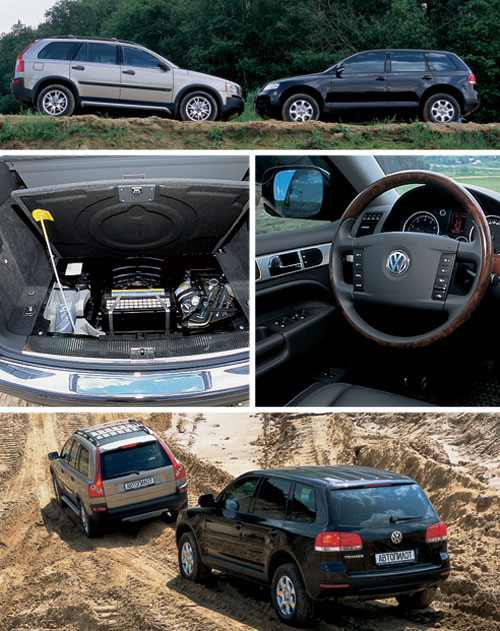
Figure Second: Cadrille. Here it is - the normal owner of an all -terrain vehicle will never miss such an opportunity. A hundred meters from the highway opens a small sandy quarry. We turn and stop in front of a deep rut, sold in a mixture of clay and sand with formidable construction equipment. We are the first to launch the Volvo XC90-it copes with the obstacle to playfully, only an unpleasant rattle is heard from under the bottom-rather large cobblestones are found between the ruts. Touareg slides the track silently-after all, he has a little more clearance.
Having mastered the career at the bottom, we begin to courageous - write eights and circles on sand and clay. Moreover, on Touareg we decided not to turn on a low gear in order to save the status-quo. And although the rubber on the VW was all -resistant, and on Volvo it was highlighted, on a rather dense ground, this advantage of Touareg was not felt - Volvo takes its own due to the engine power and the stretched torque, which reaches the maximum at 1800 rpm.
We complicate the task and decide on the assault on a rather steep slope, decently plowed with the same trucks. To begin with, on the machine, with acceleration. Neither Volvo nor VW have problems. Only on the crest under the belly of the XC90, a nasty crunch is heard again ... our exercises are interrupted by a photographer who also needs to work. The first requirement is to hang at the moment when the hood looks into the sky. Since more accurate work is required, we switch to manual mode. Here we understood one more thing: from a place to a steep rise, cars crawl out differently. Touareg performs this more confidently, immediately from the second gear. But Volvo does not touch the second, and in the first gear in the first second he tries to seduce with front wheels - the electronics of the distribution of traction effort are not so quickly triggered.
The same system played a cruel joke with us while trying to climb the hill backwards. Remember: such jokes do not pass with Volvo XC90. It accelerates well on a flat area, but as soon as the rise, the car begins to demolish. It cannot be otherwise - by default, the XC90 is front -wheel drive. The wheels confidently push it until the moment until they begin to slip. Electronics quickly throws the torque to the rear wheels (which are the front in such a situation), and ... the car blows to the right or to the left. And Touareg easily did all these exercises and became on the roads a recognized leader.
Figure is third: a change of partner. But what about the answer to the eternal question of what to take?. In the city and on the asphalt of the Volvo XC90, it is definitely better if you compare it with a close in spirit Touareg 3.0. On relatively light off -road, cars are almost equal, but Touareg has a much larger margin of safety. At the same time, we did not fundamentally include the handout on VW and did not block the inter -Eose differential, relying on electronics. So Touareg is able to drive where on Volvo should not definitely climb. We also recommend taking into account the next two paragraphs. This, so to speak, is the first experience of practical operation of machines.
So, after the publication of the material about the diesel version of the Touareg 5.0 TDI (autopilot #7, 2003), the reader, Mr. Usov called us, and peremptorly stated: tired of reading the victorious relations. I am almost the first owner of Touareg 3.0 in Russia, and life is not as beautiful as it seems, especially after the first 10 thousand kilometers. It turned out that the first cars in the operation of the operation crawled out an extraordinary defect - vibration on the steering wheel. The reason is the front cardan and suspension bearing. The defect was recognized as tribal and now they are fighting with it. Still on the service they cannot understand the reasons for the knocks in the box, which are clearly audible during movement, and dancing revolutions of the idle stroke, which arise after the car rests for a couple of days. The replacement of the hydraulic rector of the headlights looks like a trifle against this background. But, thank God, while all work is carried out under warranty.
With Volvo is easier. Almost all the main nodes and assemblies have already been licked to the XC70 model, and the innovations did not affect the production technology too deep. Most likely, nothing unexpected with her should happen if you follow the recommendations of the manufacturer and autopilot. From ourselves, we will advise you not to jump on the bumps at a speed close to 100 km/h - this racks of shock absorbers can not withstand. As for the electronics that control the engine, we note that the T6 motor is produced for five years and has already got rid of innate defects.
Text Nikolay Kachurin, photo Sergey Sherestnikov
Model/Modification Volkswagen Touareg 3.2 Volvo XC90 T6
Manufacturer/country Volkswagen AG/Germany Volvo Car Corporation/Sweden
Bearing element of the body
Number of doors/places 5/5
ENGINE
Type/number/location of gasoline cylinders/6/V-shaped gasoline, with turbocharged, with two intermediate coolers/6/row
Working volume (cubic meter) 3198 2922
Power (kW (L.S.) at about./Min.) 162 (220) at 6400 200 (272) at 5100
Moment (Nm at about./Min.) 305 at 3200 380 at 1800-5000
TRANSMISSION
Permanent drive full, 4 motion constant full
Automatic gearbox, 6-speed, Tiptronic Automatic 4-speed type GEARTRONIC
Gear rates (increased/lowered) 1/2.7 no
Brakes, safety
Front/rear circular ventilated
ABS, assisting electronic systems 4-channel; ESP and Brake Assist 4-channel systems; EBV and DSTC systems
Front and side airbags for the driver and passenger, inflatable curtains on all side windows
Dimensions/mass
Length/width/height (mm) 4754/1928/1703 4800/1890/1740
Wheel base/clearance (mm) 2855/235 2860/220
Tires 235/65 R17
Mar is equipped/complete (kg) 2215/2945 1982/2250
The volume of the fuel tank (L) 100 72
Maximum speed (km/h) 201 210
Acceleration to 100 km/h (sec.) 9.9 9.3
Fuel consumption (city/highway, l/100 km) 19.1/10.8 18.5/9.6
Price in Moscow from $ 50,000 $ 63 800
Source: "Autopilot"
VOLKSWAGEN TOUAREG 2002 - 2007
Volkswagen Touareg 2002 test drives - 2007
Krash Test Volkswagen Touareg 2002 - 2007
Krassh Test: Detailed Information34%
Driver and passengers
7%
Pedestrians
39%
Children-passengers
Malfunctions Volkswagen Touareg 2002 - 2007
Volkswagen Touareg malfunctions: Detailed information| Touareg 2002 - 2007 | |
|---|---|
| Engine |  |
| Transmission |  |
| Control system and suspension |  |
| Brake system |  |
| Air heating and air conditioning |  |
| Launch and charging system |  |
| Electric components and so on |  |
| Corrosion body stability |  |


